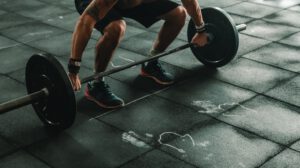HIIT, or High-Intensity Interval Training, is a type of exercise that involves short bursts of intense activity followed by brief periods of rest. HIIT workouts are typically shorter than other types of workout, such as steady-state cardio, but they can be just as effective at improving fitness and burning calories.
You alternate between high-intensity exercises and lower-intensity or rest periods during a HIIT workout. For example, 30 seconds of sprinting followed by 30 seconds of walking or jogging. High-intensity activities can be any exercise that increases your heart rate, such as jumping jacks, burpees, or mountain climbers.
HIIT workouts are popular because they can be customized to fit your fitness level and can be done with minimal equipment. They also tend to be more efficient than other types of workouts since you can get a lot of benefits in a short amount of time. However, they can be challenging, so it’s essential to build up your intensity gradually. It’s also a good idea to warm up before starting a HIIT workout and to cool down afterward.
HIIT benefits for your body and mind
Here are some potential benefits of HIIT for both the body and mind:
- Improved cardiovascular fitness: HIIT workouts can increase your heart and lung capacity, leading to improved cardiovascular fitness.
- Increased metabolism: HIIT workouts can boost your metabolism, which means you may continue to burn calories at a higher rate even after the workout.
- Increased muscle strength and tone: HIIT workouts can help you build and tone muscle, especially when combined with strength training exercises.
- Increased fat loss: HIIT workouts can effectively burn fat, especially when combined with a healthy diet.
- Improved mental focus and concentration: HIIT workouts can help improve your mental focus and concentration, as they require you to stay engaged and focused during the workout.
- Increased energy: HIIT workouts can help improve your energy levels and overall well-being.
- Improved sleep: HIIT workouts help improve your sleep, as regular exercise has been shown to help people fall asleep more quickly and sleep more soundly.
It’s important to note that the benefits of HIIT will vary from person to person, and it’s always a good idea to speak with a healthcare professional before starting any new exercise program.
How does a HIIT workout work?
HIIT workouts typically involve repeating a series of high-intensity exercises followed by brief periods of rest or lower-intensity exercises. The length and intensity of the intervals can vary depending on the specific workout.
A typical HIIT workout might involve 30 seconds of high-intensity exercise followed by 30 seconds of rest, repeated for a set number of rounds.
For example, a HIIT workout might involve doing the following exercises for 30 seconds each, with 30 seconds of rest in between:
- Sprinting or running in place
- Jumping jacks
- Burpees
- Mountain climbers
- Push-ups
- Squats
- Plank
After completing the exercises, you would take a longer break (usually a few minutes) before starting the next round. The number of rounds and the length of the intervals can be adjusted based on your fitness level and goals.
It’s important to start slowly and build up your intensity gradually, as HIIT workouts can be pretty challenging. It’s also a good idea to warm up before starting a HIIT workout and to cool down afterward to help prevent injury.
How often should you do HIIT workout routines?
The frequency of HIIT workouts will depend on your fitness level, goals, and overall exercise routine. In general, it’s a good idea to start slowly and gradually increasing your HIIT workouts frequency as you become more fit.
For beginners, starting with two to three HIIT workouts per week is generally recommended, with at least one day of rest in between sessions. As you become more comfortable with the workouts and start to see improvements in your fitness, you can gradually increase the frequency to four to five days per week.
It’s important to remember that HIIT workouts are intense and challenging, so giving your body adequate time to recover between sessions is essential. It’s also a good idea to incorporate other types of exercise, such as steady-state cardio and strength training, into your routine to help balance out the demands on your body.
As with any exercise program, it’s a good idea to consult with a healthcare professional before starting a HIIT program to ensure it’s appropriate for you and to get guidance on progressing safely.
HIIT afterburn effect
The afterburn effect, also known as excess post-exercise oxygen consumption (EPOC), refers to the increased rate at which your body burns calories after intense exercise. It’s thought to occur because your body needs to restore itself to its pre-exercise state, which requires energy from calories.
Some research suggests that HIIT workouts may be more effective at increasing the afterburn effect than steady-state cardio workouts. However, the magnitude of the impact may vary depending on the specific exercise and the individual.
It’s important to note that the afterburn effect is just one factor that can contribute to overall weight loss or maintenance. While it may help you burn additional calories, paying attention to your overall calorie intake and incorporating other types of exercise into your routine to achieve your fitness goals is still important.
Best HIIT exercises to include in your workout routine.
Many exercises can be incorporated into a HIIT workout; the best ones depend on your fitness level and goals. Here are a few examples of exercises that are commonly used in HIIT workouts:
- Sprinting or running in place: These exercises can help increase your cardiovascular endurance and can be done with or without a treadmill.
- Jumping jacks: This classic exercise can help improve your coordination and cardiovascular endurance.
- Burpees: This full-body exercise involves a push-up, squat, and jump, making it a great way to get your heart rate up and work for multiple muscle groups at once.
- Mountain climbers: This exercise involves alternating between bringing each knee up to your chest while in a plank position, which can help improve your cardiovascular endurance and core strength.
- Push-ups: This classic exercise works your chest, shoulders, and triceps and can be modified to fit your fitness level.
- Squats: This exercise works your lower body and can be modified by adding weight or using a chair or wall for support.
- Plank: This exercise involves holding a position in which you support your body weight on your hands and toes, which can help improve your core strength and stability.
It’s a good idea to vary your HIIT workouts by incorporating different exercises to challenge your body and avoid boredom.
A sample HIIT workout routine in a weekly basis.
Here is a sample HIIT workout routine that you could follow weekly:
Monday:
- Warm up with 5-10 minutes of light cardio (such as jogging or cycling)
- Complete three rounds of the following circuit, resting for 30 seconds in between each exercise:
- 30 seconds of sprinting or running in place
- 30 seconds of jumping jacks
- 30 seconds of burpees
- 30 seconds of mountain climbers
- 30 seconds of push-ups
- 30 seconds of squats
- 30 seconds of plank
- Cool down with 5-10 minutes of stretching
Wednesday:
- Warm up with 5-10 minutes of light cardio (such as jogging or cycling)
- Complete three rounds of the following circuit, resting for 30 seconds in between each exercise:
- 30 seconds of jump squats
- 30 seconds of high knees
- 30 seconds of the plank with shoulder taps
- 30 seconds of reverse lunges
- 30 seconds of bicycle crunches
- 30 seconds of plank jacks
- 30 seconds of side plank (on each side)
- Cool down with 5-10 minutes of stretching
Friday:
- Warm up with 5-10 minutes of light cardio (such as jogging or cycling)
- Complete three rounds of the following circuit, resting for 30 seconds in between each exercise:
- 30 seconds of jump rope
- 30 seconds of squat jumps
- 30 seconds of the plank with hip dips
- 30 seconds of lunge jumps
- 30 seconds of Russian twists
- 30 seconds of the plank with leg lifts (on each side)
- 30 seconds of side plank with leg lift (on each side)
- Cool down with 5-10 minutes of stretching
It is just one example of a HIIT workout routine, and you can customize it to fit your fitness level and goals. It’s important to start slowly, gradually build up your intensity, and give your body adequate time to rest and recover between workouts. It’s also a good idea to incorporate other types of exercise, such as steady-state cardio and strength training, into your routine to help balance out the demands on your body.
Diet plan for HIIT workout
Eating a balanced diet is important to support your exercise routine and help you achieve your fitness goals. Here are a few general guidelines to follow when planning your diet:
- Eat enough calories: Ensure you’re getting enough calories to support your exercise routine and daily energy needs. If you’re trying to lose weight, you may need to reduce your calorie intake slightly. Still, it’s essential not to cut calories too drastically, as this can negatively impact your performance and overall health.
- Choose nutrient-dense foods: Focus on getting a variety of nutrient-dense foods, such as fruits, vegetables, whole grains, lean proteins, and healthy fats. These foods will help provide the nutrients your body needs to support your workouts and overall health.
- Stay hydrated: Ensure you’re drinking enough water to stay hydrated before, during, and after your workouts. Dehydration can negatively impact your performance and overall health.
- Eat enough protein: Protein is vital for building and repairing muscle tissue, and getting enough protein can help support muscle recovery and growth. Aim to include a source of protein in each meal and snack.
- Eat pre- and post-workout snacks: Eating a small snack before and after workouts can help fuel your body and promote muscle recovery. Good options include a banana with peanut butter or a protein shake.
It’s also a good idea to work with a registered dietitian or nutritionist to develop a customized meal plan that meets your specific needs and goals. They can help you create a balanced, healthy diet that supports your workouts and overall health.
A weekly example diet plan for a HIIT workout routine.
Here is an example weekly diet plan that follows the guidelines I provided for a HIIT workout routine:
Monday:
- Breakfast: Overnight oats with berries and nuts
- Snack: Apple slices with almond butter
- Lunch: Grilled chicken salad with mixed greens, vegetables, and a vinaigrette dressing
- Snack: Greek yogurt with berries and a sprinkle of granola
- Dinner: Grilled salmon with roasted vegetables and quinoa
Tuesday:
- Breakfast: Scrambled eggs with whole wheat toast and avocado
- Snack: Carrot sticks with hummus
- Lunch: Turkey and avocado wrap with mixed greens and a side of fruit
- Snack: Hard-boiled egg with cherry tomatoes
- Dinner: Baked sweet potato with black beans, salsa, and Greek yogurt
Wednesday:
- Breakfast: Smoothie with banana, spinach, protein powder, and almond milk
- Snack: Apple slices with peanut butter
- Lunch: Grilled chicken and vegetable skewers with brown rice
- Snack: Greek yogurt with berries and a sprinkle of granola
- Dinner: Grilled shrimp with quinoa and steamed broccoli
Thursday:
- Breakfast: Overnight oats with berries and nuts
- Snack: Apple slices with almond butter
- Lunch: Turkey and avocado wrap with mixed greens and a side of fruit
- Snack: Hard-boiled egg with cherry tomatoes
- Dinner: Baked sweet potato with black beans, salsa, and Greek yogurt
Friday:
- Breakfast: Scrambled eggs with whole wheat toast and avocado
- Snack: Carrot sticks with hummus
- Lunch: Grilled chicken salad with mixed greens, vegetables, and a vinaigrette dressing
- Snack: Greek yogurt with berries and a sprinkle of granola
- Dinner: Grilled salmon with roasted vegetables and quinoa
It is just one example of a weekly diet plan that could support a HIIT workout routine. It’s important to remember that everyone’s nutritional needs are different, and it’s a good idea to work with a registered dietitian or nutritionist to create a customized meal plan that meets your specific needs and goals.
More tips to remember
Here are a few additional tips to consider when incorporating HIIT workouts into your fitness routine:
- Start slowly and gradually increase intensity: HIIT workouts can be challenging, so it’s essential to start slowly and progressively increase the intensity as you become more comfortable with the workouts.
- Vary your workouts: Mixing up your HIIT workouts by incorporating different exercises and intervals can help prevent boredom and keep your body challenged.
- Warm-up and cool down: It’s important to warm up before starting a HIIT workout and to cool down afterward to help prevent injury. A warm-up might include light cardio and stretching, while a cool-down might consist of stretching and foam rolling.
- Listen to your body: HIIT workouts can be intense, so you must listen to your body and take breaks as needed. It’s also essential to give your body adequate time to rest and recover between workouts.
- Mix up your workouts: In addition to HIIT workouts, it’s a good idea to incorporate other types of exercise, such as steady-state cardio and strength training, into your routine to help balance out the demands on your body and avoid overuse injuries.
- Remember to stretch: Stretching is essential for maintaining flexibility and helping your muscles recover after a workout. Make sure to include stretching in your cool-down routine.
- Seek guidance from a healthcare professional: It’s always a good idea to speak with a healthcare professional before starting any new exercise program to ensure it’s appropriate for you and to get guidance on how to progress safely.
These tips are helpful as you incorporate HIIT workouts into your fitness routine. Remember to start slowly and gradually increase intensity as you become more comfortable with the workouts, and to listen to your body and take breaks as needed. Good luck on your fitness journey, and don’t hesitate to reach out if you have any more questions!










0u8mc4